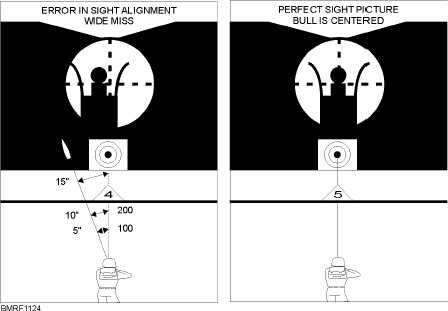ranges. This means that the sight picture will vary not
only from one firing position to another but also from
one firing line to another (fig. 11-25).
TRAINING.—You will receive training in aiming
along with the position and trigger squeeze before
actually firing on the rifle range. You do this by aiming
at a series of small bull’s-eyes at least 20 feet away on a
dry firing range; this training is known as snapping in.
BLACKENING SIGHTS.—You should blacken
the sights during sighting and aiming exercises to help
eliminate light reflection or glare. Blacken all sights,
both front and rear, on the base of the receiver and the
top of the barrel. Usually, sights are blackened by using
a smudge pot, carbide lamp, oily patch, candle, cigarette
lighter, or ordinary match. Be sure to remove all oil from
the sight before blackening it.
Shooting Positions
For the best results in rifle shooting, you need to
shoot in the correct shooting position. The better the
position, the easier it is to hold the rifle and squeeze the
trigger while the sights are properly aligned on the
target. However, shooting position won’t compensate
for lack of practice. You may have difficulty in
assuming a correct position until sufficient practice has
limbered up your muscles. Once your muscles are
limber, you will find the positions both comfortable and
steady.
A standard qualification course requires you to
learn and use three standard positions while
shooting—standing, kneeling, and sitting. Experience
has proved that these positions produce excellent results
with men and women of all physical types.
Once you master the correct positions, you must
combine sighting and aiming with your practice. Learn
to get into the correct position and align the sights
without moving the rifle. If the target isn’t properly
aligned with the sights, you must move your body
11-17
Student Notes:
Figure 11-24.—Error in sight alignment increases as range increases.
Figure 11-23.—6 o’clock sight picture held on a “D” target
at a range of 200 yards.




